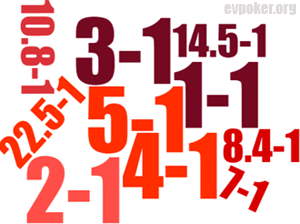Pot odds and implicit odds
 Besides strategic knowledge, you must have a constant idea about the probabilities in the situations that occur to be successful in poker. The knowledge about probabilities is expressed in odds and two important concepts are pot odds and implicit pot odds.
Besides strategic knowledge, you must have a constant idea about the probabilities in the situations that occur to be successful in poker. The knowledge about probabilities is expressed in odds and two important concepts are pot odds and implicit pot odds.
Pot odds
Pot odds are a central area of Texas hold'em and in other forms of poker. The essence of pot odds is to know the value of a hand or drawing hand in relation to the money in the pot. Speaking more concretely, it's about knowing when to call or fold depending on the ratio between the pot and the cost of the call according to probabilities.
You have the hole cards 7♥-9♦ and the flop comes K♥-6♣-T♣. As you can see, you haven’t hit anything yet, but you would like to see more cards, since you have a drawing hand. You would be very satisfied if the 8 come up, wouldn’t you? That would give you a 6-T straight.
Before the next card, the player before you bet 10 units. Are you going to fold or call? (There are no other players in the pot.) To answer this correctly, we must look at the size of the pot. There are 100 units in the pot including the last bet.
The mission is now to calculate the odds that you make your straight. You need an 8 to do this, which means you have 4 outs among 47 unknown cards. That gives you the drawing odds 10.8:1 approximately 11:1. The 11:1 means that something happens in total 12 times (11+1) and that the specific thing happen once (1).
Since there are 100 units in the pot and the cost of the call is 10 it gives you a 10:1 (100:10) pot odds. That actual drawing odds (11:1) in relation to the pot odds (10:1) gives you a negative expectation, and therefore the right decision is to fold.
Your hand in this situation is just not worth to play because you will lose money with it in the long run, and in poker the long range terms are essential for your total profit.
In this example, we focused strictly about the odds. This, however, doesn’t mean that you from now on should play within an exclusive mathematic perspective. The importance of pot odds varies among the forms of Texas hold'em (pot odds are more important in Limit compared to No Limit) and of the situation in general, but it’s still a fundamental matter to care about when playing.
Implicit pot odds
Hopefully you don’t find the concept of pot odds all too complicated. In that case, you should probably wait before you try to understand implicit pot odds, since it is even a bit more complicate. On the other hand, it’s the same concept with just a few more aspects.
Let’s use the example once again. We know that the player before you has bet 10 units and it’s 100 in the pot. What about the action after the 4th and the 5th cards? Doesn’t this affect the decision on the flop? Yes, it does. You must also take into consideration what is likely to happen in the following betting rounds. Suppose that your opponent will bet again after the turn and the river, this will change the pot odds.
Therefore, you should also include the effective and implicit odds in your calculation. We will go back and decide if to make the call once again. You expect that your opponent bets 10 units again after the turn and that implies 110 units in the pot. The actual drawing odds are still (10.5:1), but the pot odds are now (11:1). This time it gives you a positive expectation.
The implicit pot odds differ, as you have noticed, from ordinary pot odds as it in some way is about guessing. Having an idea about the implicit odds is something you get from all your information in the hand and that you know about the other player from earlier hands.
Related articles:
